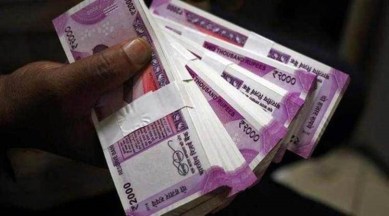Banking system liquidity improves to over Rs 2 lk cr as deposit of Rs 2000 notes surge
On July 4, the excess liquidity, as reflected by the amount of money absorbed by the Reserve Bank of India (RBI), stood at Rs 2.3 lakh crore- highest in one month. The central bank absorbed Rs 2.22 lakh crore of surplus liquidity on July 3, RBI data showed.

With large amounts of the Rs 2,000 denomination notes being deposited in banks and an increase in government spending, the surplus liquidity in the banking system has crossed Rs 2 lakh crore mark.
On July 4, the excess liquidity, as reflected by the amount of money absorbed by the Reserve Bank of India (RBI), stood at Rs 2.3 lakh crore- highest in one month. The central bank absorbed Rs 2.22 lakh crore of surplus liquidity on July 3, RBI data showed.
monthly limit of free stories.
with an Express account.
The RBI recently said that Rs 2.72 lakh crore, or 76 per cent of Rs 2,000 banknotes in circulation as on May 19, 2023 have returned to the banking system as at end-June. Of the total amount of Rs 2,000 banknotes received as on June 30, about 87 per cent were in the form of deposits and the remaining around 13 per cent were exchanged into other denomination banknotes, the RBI said.
RBI had announced to withdraw the Rs 2,000 note from circulation from May 19, while maintaining its legal tender status. The total value of Rs 2,000 banknotes in circulation stood at 3.56 lakh crore on May 19, which declined to Rs 0.84 lakh crore as on June 30, the RBI said.
“Liquidity condition has improved because of the month (June)-end spending by the government for salaries and other payments. Besides, a lot of Rs 2,000 currency notes have returned in the form of deposits, which has also helped in surplus liquidity getting built-up,” said a banker.
After peaking at Rs 2.6 lakh crore on June 4, the excess liquidity in the system declined to around Rs 18,657 crore on June 19 post the payouts related to the advance tax and Goods and Services Tax (GST).
Between June 19 and June 29, the RBI’s daily average absorption of surplus liquidity was around Rs 36,000 crore.
The surplus in liquidity recovered to Rs 1.26 lakh crore on June 30. The RBI sucked out on an average Rs 1.8 lakh crore daily of excess liquidity from the banking system between June 30 and July 4, the RBI data showed.
The RBI has been conducting variable rate reverse repo (VRRR) auctions of various tenors to absorb excess liquidity from the banking system.
In the two-day VRRR auction conducted on Wednesday, banks parked Rs 87,870 crore with the RBI as against the notified amount of Rs 1 lakh crore.